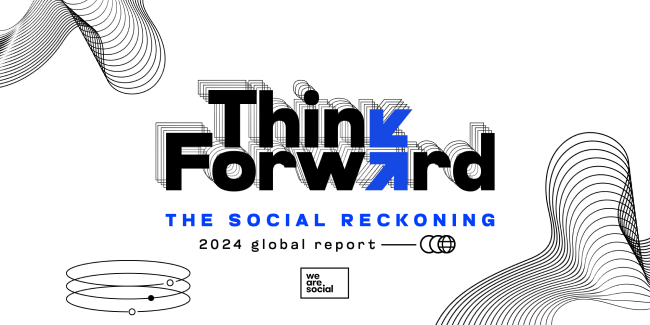We Are Social’s Mobbie Nazir introduces the agency’s 2024 edition of Think Forward, its report on the shifting landscape of social media - The Social Reckoning suggests users are increasingly aware of how brand-heavy the internet has become and are reacting accordingly; marketers need to understand and join forces with this new wave of creativity.
When we did the analysis of the latest and upcoming trends on social media for our 2024 Think Forward report, digging through everything from sludge content to nuanced takes on gender identity to Barbie (don’t ask), it soon became evident that a ‘social reckoning’ has emerged.
The Social Reckoning became the title of the report because it was clear that, against a backdrop of increased online commercialisation and commodification, people on social media are rethinking and reframing their worth.

In a digital marketing industry built on understanding and exchanging value, it’s almost surprising that it’s taken this long for consumers and users to themselves examine the value derived from their attention and participation, their communities, and their creativity.
But, evidence suggests we have arrived. We’ve begun to see how this new sense of value has played out across social spaces, from the ongoing debate around users being able to buy their way into verification on X (formerly Twitter), to the de-influencing trend that’s helping creators flex what they know, rather than what they have.
We’ve even seen how cultural phenomena like 2023’s ‘Barbiemania’ demonstrate that people will freely buy into manufactured hype, as long as it makes space for community, creativity, and play.
What to expect in 2024
The report highlights five trends within ‘The Social Reckoning’ theme. It explores how each is expected to shape the face of social media over the next 12 months and how brands can use these within their marketing strategies.
It was compiled by We Are Social’s cultural insights team, gathering insights from teams on the ground across our 19 global markets. This was combined with interviews with external experts to help We Are Social understand broad cultural context, the social media zeitgeist and voices outside the mainstream.
The trends we identified suggest that people are growing increasingly aware of how commercialised social spaces have become, how much content is out there screaming (or in some cases, whispering) for their attention, and how much more creative they’re choosing to be as a result:
Offline Internet
For one, we found that people are looking for more interaction between their on- and offline worlds. Today, characters, communities, and behaviours born on the internet are moving seamlessly into offline worlds. And this interplay isn’t just tolerated – it’s expected.
Look at Drake, who satirically integrated Snapchat’s iconic ‘crying face’ AR Filter into his live performance of ‘Laugh Now, Cry Later’, turning the faces in the crowd into weeping faces. He generated millions of views and earned media for his blurring of real and fake, online and IRL.
Attention Layering
Having reached peak stimulus with ‘sludge content’, the attention economy is shifting gears and we’re seemingly heading into the immersion economy instead. The most forward-thinking users, creators, and culture-leading brands are toying with other modes of bringing people in – ones that turn away from hyper-stimulation and offer a more ‘background music’ approach.
For example, the viral Wes Anderson aesthetic uses the director’s signature style to make everyday scenes – lunch, train rides, uneventful wanders – into an artful visual experience.
Everyday Fandom
The year of Barbenheimer and Tay-Tay’s Eras Tour has made it clear: in search of mainstream collectivity, everyday consumers are acting like ultra-fans. The lines between fan and non-fan are increasingly blurred, as we all engage in fan behaviours and immerse ourselves in collective moments.
We’ve seen IKEA tap into the potent anime fandom to grow market share. Its recent back-to-school spot taps into a cultural space popular with Gen Z to establish a meaningful connection with the next generation and become an integral part of their lives.
Post-Representation
People – whether minorities, disempowered groups, or just users writ large – value representation. But in today’s culture, there’s less faith in the power of representation alone. Notions of identity are compounding and deepening, so communities want to see messy complexity over neat narratives.
On Reddit, people are using spaces like r/AskBlackGirls, r/AskTransgender, r/AskGayBrosOver30 to help people gain a more nuanced understanding of marginalised groups’ lived reality – but now through exploratory, anonymous storytelling rather than loud ‘representation’.
Mischief Mode
We’ve seen social media and the internet become more commoditised, and so users are breaking out of its commercial structures in an attempt to reclaim creativity. Amidst the homogenisation of online spaces, there's a compelling counter-trend emerging, spearheaded by younger generations.
It often comes with a sense of mischief. To prove that its products couldn’t be duplicated, haircare brand Olaplex duped the internet with a phoney influencer campaign promoting the fictitious Oladupé No.160. Olaplex championed its range and decried unsavoury business practices, all at once.
Overall, The Social Reckoning highlights that users are increasingly aware of how brand-heavy the internet has become and are reacting accordingly. It suggests marketers may have to rethink some of their more obvious approaches and may instead have to combine forces with this new wave of creativity.

